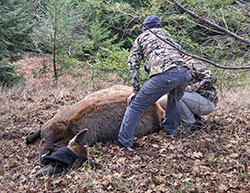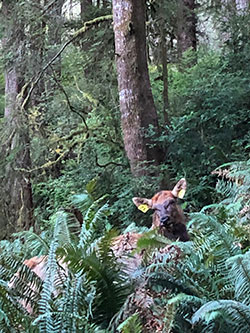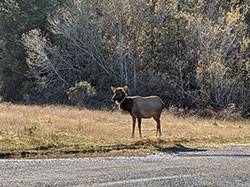Despite their massive size and majestic appearance, Roosevelt elk have proved an elusive research subject because of the dense forests they inhabit. CDFW recently initiated one of the largest Roosevelt elk capture and collaring efforts in state history.
Logan Weyand, left, a veterinary student form Washington State University, and Drew Trausch, a scientific aid with CDFW’s Big Game Program, help capture and collar a cow Roosevelt elk in Humboldt County this past fall. CDFW photo by Shwn Fresz.

CDFW crews work quickly to tag and collar a tranquilized cow elk in Humboldt County. CDFW photo by George Harse.

Sporting ear tags and a GPS tracking collar, a cow Roosevelt elk returns to heavy timber after being sedated. CDFW photo by Andrew Trausch.

Ear tags provide biologists with visual identification of Roosevelt elk study animals while GPS tracking collars can provide years worth of detailed date on movement and habitat preferences. CDFW photo by George Harse.
State biologists are now learning a great deal about California’s largest land mammal.
Roosevelt elk are one of three subspecies of elk native to California, joining the tule elk (the smallest of the three) and the Rocky Mountain elk. While a bull Rocky Mountain elk will have larger and more impressive antlers, the Roosevelt elk bests it in body mass. A bull Rocky Mountain elk can reach 700 pounds while a bull Roosevelt can exceed 1,000 pounds.
Despite their massive size and majestic appearance, Roosevelt elk have proved an elusive research subject because of the dense forests they inhabit. Aerial surveying and trapping – standard tools for counting and collaring deer, elk and bighorn sheep in more open parts of the state – can be challenging for Roosevelt elk moving in and out of heavy coastal timber.
While deer often can be darted and tranquilized using a biologist’s truck as cover, Roosevelt elk are more wary and vehicle-shy, often requiring a lengthy stalk and serious hunting skills to get within the 50-yard effective range of a dart gun. In some cases, it can take more than 100 hours to capture and collar an individual Roosevelt elk.
In an attempt to close the knowledge gap, CDFW recently initiated one of the largest Roosevelt elk capture and collaring efforts in state history, targeting a population of Roosevelt elk living along the U.S. 101 corridor in Humboldt and Del Norte counties. The effort is part of an ongoing study that began in 2016, explained Carrington Hilson, CDFW’s lead elk research biologist on the north coast. The study will continue through 2025.
Since November, Hilson and her colleagues have affixed GPS tracking collars on 24 cow Roosevelt elk in Humboldt and Del Norte counties to monitor their movements and migrations. CDFW biologists plan to collar another 14 cows this winter.
Several ancillary projects – estimating populations using fecal DNA, looking at calf survival and understanding habitat use – are also underway at Humboldt State University in Arcata in coordination with CDFW that will add to the state’s body of knowledge.
A few factors are driving the research interest, explained Kristin Denryter, the Sacramento-based senior environmental scientist who oversees CDFW’s Elk and Pronghorn Antelope Program. The first is an increasing number of human-elk conflicts along the U.S. 101 corridor that include vehicle collisions, property damage and agricultural losses suffered by north coast farmers and ranchers.
The second driver is technology. Advances in GPS tracking collars make them an increasingly valuable research tool. The new elk collars will record data every six hours over the life of the study and deliver that information daily to CDFW biologists.
Lastly, there is the California Essential Habitat Connectivity Project and U.S. Department of the Interior Secretarial Order 3362 (SO 3362).
Signed in 2018, SO 3362 directs federal agencies to work with California and other western state wildlife agencies to improve the quality of big-game winter range habitat and migration corridors on federal land. The order provided funding for CDFW to acquire the 38 GPS tracking collars and accelerate its research efforts. The collar data will improve understanding of movement and habitat use to inform habitat enhancement on public lands as well as help guide development of potential crossing structures to not only improve habitat connectivity but to also improve public safety by reducing vehicle collisions. CDFW has partnered with CalTrans on improving connectivity as part of the California Essential Habitat Connectivity Project.
A Roosevelt elk stakeholder group made up of CDFW representatives, tribal interests, farmers, ranchers and local officials is also being developed.
Official estimates put the Roosevelt elk population along the U.S. 101 corridor in Humboldt and Del Norte counties at 1,600 animals. Biologists, however, suspect those estimates to be low. In an attempt to reduce growing human-elk conflicts, CDFW issued 20 additional Roosevelt elk tags during the 2019 hunting season through its SHARE program, which provides public hunting opportunities on private land through cooperating landowners. CDFW is currently petitioning the California Fish and Game Commission to increase the allotment of Roosevelt elk tags available along the north coast in the 2020 fall hunting season.
Translocations, limited hunting, high calf survival, and conservation management have all helped boost Roosevelt elk populations from lows in the early 1900s to a robust statewide estimate today of 5,700 animals. Roosevelt elk also occupy parts of Mendocino, Trinity, Shasta, Tehama and Siskiyou counites.
The U.S. 101 corridor population in Humboldt and Del Norte counties has proved particularly adaptable – as comfortable roaming the beaches of state parks as they are grazing in open alfalfa fields or wandering underneath the forest canopy. That’s made them especially popular with tourists and some locals but not so much with farmers and ranchers suffering property damage and crop losses from the expanding herds.